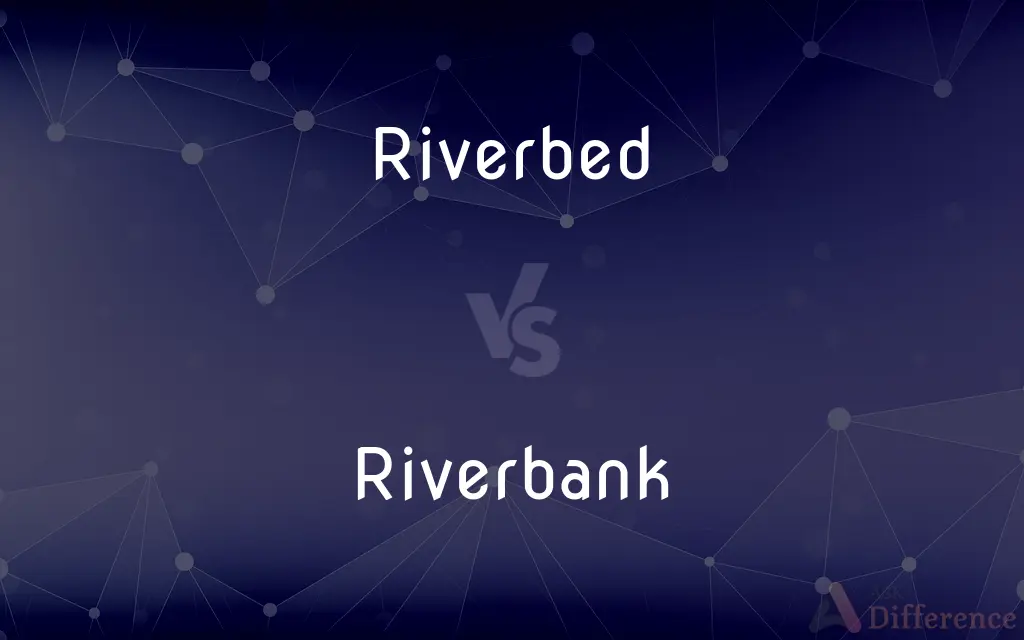Riverbed vs. Riverbank — What's the Difference?
By Fiza Rafique & Maham Liaqat — Updated on April 24, 2024
A riverbed is the bottom of a river where water flows, often consisting of sand, rocks, or silt, while a riverbank is the side of a river, supporting plant life and providing habitat.

Difference Between Riverbed and Riverbank
Table of Contents
ADVERTISEMENT
Key Differences
The riverbed is the submerged ground over which a river flows, primarily composed of materials like gravel, boulders, or sediments, depending on the river’s location and flow characteristics. On the other hand, riverbanks are the sides of a river that hold the water within its boundaries and are often covered in vegetation that can stabilize the soil and prevent erosion.
Riverbeds are directly influenced by the volume and speed of the water that flows over them, shaping their composition and structure through processes like erosion and deposition. Riverbanks, however, are affected by both the water within the river and the surrounding land; they can erode with fast-moving water or expand during periods of lower flow.
The ecological role of a riverbed is crucial as it provides habitat for aquatic organisms, including fish and invertebrates, which can hide among the rocks and sediments. Conversely, riverbanks support a variety of terrestrial and semi-aquatic plants and animals, offering shelter and feeding grounds.
In terms of human interaction, riverbeds may be sites for activities like fishing or gold panning, where direct access to the river’s flow is necessary. Riverbanks are more accessible and are commonly used for recreational activities such as picnicking, hiking, or simply enjoying the scenic views.
Maintenance and preservation efforts differ significantly between the two; riverbeds often require dredging to maintain navigability or to prevent flooding, while riverbanks might need reinforcement with riprap or vegetation to combat erosion and maintain their integrity.
ADVERTISEMENT
Comparison Chart
Definition
The bottom surface of a river
The sides of a river
Composition
Sand, rocks, silt
Soil, vegetation
Ecological Role
Habitat for aquatic life
Supports terrestrial and semi-aquatic life
Human Interaction
Used for fishing, gold panning
Used for recreation, habitat preservation
Maintenance Needs
Dredging to maintain depth and flow
Reinforcement to prevent erosion
Compare with Definitions
Riverbed
Shaped by the flow of water.
Strong currents smoothed the stones in the riverbed.
Riverbank
The sides of a river channel.
We walked along the riverbank enjoying the wildflowers.
Riverbed
The bottom part of a river channel.
The riverbed was visible during the dry season when the water level was low.
Riverbank
Often covered in vegetation that stabilizes the soil.
The riverbank was thick with willows and reeds.
Riverbed
Consists of materials like gravel, rocks, and sediment.
Miners sift through the riverbed searching for gold.
Riverbank
Affected by water flow and land interactions.
Heavy rains caused parts of the riverbank to erode away.
Riverbed
Provides habitat for aquatic organisms.
Trout thrive in the sheltered spaces between rocks in the riverbed.
Riverbank
Needs maintenance to prevent erosion.
The community planted trees on the riverbank to strengthen it.
Riverbed
Subject to processes like erosion and deposition.
Floods last spring altered the shape of the riverbed.
Riverbank
Provides habitat for various plants and animals.
Beavers built their dams along the secluded riverbank.
Riverbed
The area between the banks of a river ordinarily covered by water.
Riverbank
The bank of a river.
Riverbed
(hydrology) The path where a river runs, or where a river once ran; the bottom earthen part of a river, not including the riverbanks.
Riverbank
A sloped side of a river acting as a barrier between the water and level ground to either side.
Riverbed
A channel occupied (or formerly occupied) by a river
Riverbank
The bank of a river
Common Curiosities
Why is vegetation important for a riverbank?
Vegetation stabilizes the riverbank soil and prevents erosion from water flow.
What types of materials can be found in a riverbed?
Riverbeds are usually made up of materials like rocks, sand, and silt.
What role does the riverbed play in the ecosystem?
The riverbed provides essential habitat for many aquatic species and plays a role in the river’s ecological balance.
How do human activities affect riverbanks?
Activities like construction, deforestation, and recreational use can lead to riverbank erosion and habitat disruption.
What are some common activities performed on riverbanks?
Common activities include picnicking, hiking, fishing from the bank, and observing wildlife.
What is the main difference between a riverbed and a riverbank?
The riverbed is the bottom surface where the river flows, while the riverbank is the side of the river.
Can the riverbed be seen without water?
Yes, the riverbed can be seen and accessed when the water level is low or during drought conditions.
Are riverbanks prone to erosion?
Yes, riverbanks are susceptible to erosion, especially in areas with strong water currents.
What is the impact of drought on riverbeds and riverbanks?
Drought can expose riverbeds and dry out riverbanks, affecting the habitats and species that rely on them.
Are riverbeds deeper than riverbanks?
The depth varies, but generally, riverbeds are at the lowest point of a river, below the level of the riverbanks.
How does vegetation affect the wildlife on riverbanks?
Vegetation provides food, shelter, and breeding grounds for various wildlife, enhancing biodiversity along riverbanks.
How do riverbeds change over time?
Riverbeds can change through natural processes like erosion, deposition, and changes in water flow.
How can riverbanks be protected from erosion?
Planting vegetation, using riprap (rocky material), and building retaining walls are common methods to protect riverbanks.
What happens during the flooding regarding riverbeds and riverbanks?
During floods, riverbeds can be reshaped, and riverbanks may erode significantly or become covered in sediment.
Can wildlife thrive in a riverbed?
Yes, many aquatic organisms thrive in riverbeds, depending on the river’s health and water quality.
Share Your Discovery

Previous Comparison
Duffel vs. Duffle
Next Comparison
Copper vs. IronAuthor Spotlight
Written by
Fiza RafiqueFiza Rafique is a skilled content writer at AskDifference.com, where she meticulously refines and enhances written pieces. Drawing from her vast editorial expertise, Fiza ensures clarity, accuracy, and precision in every article. Passionate about language, she continually seeks to elevate the quality of content for readers worldwide.
Co-written by
Maham Liaqat












































